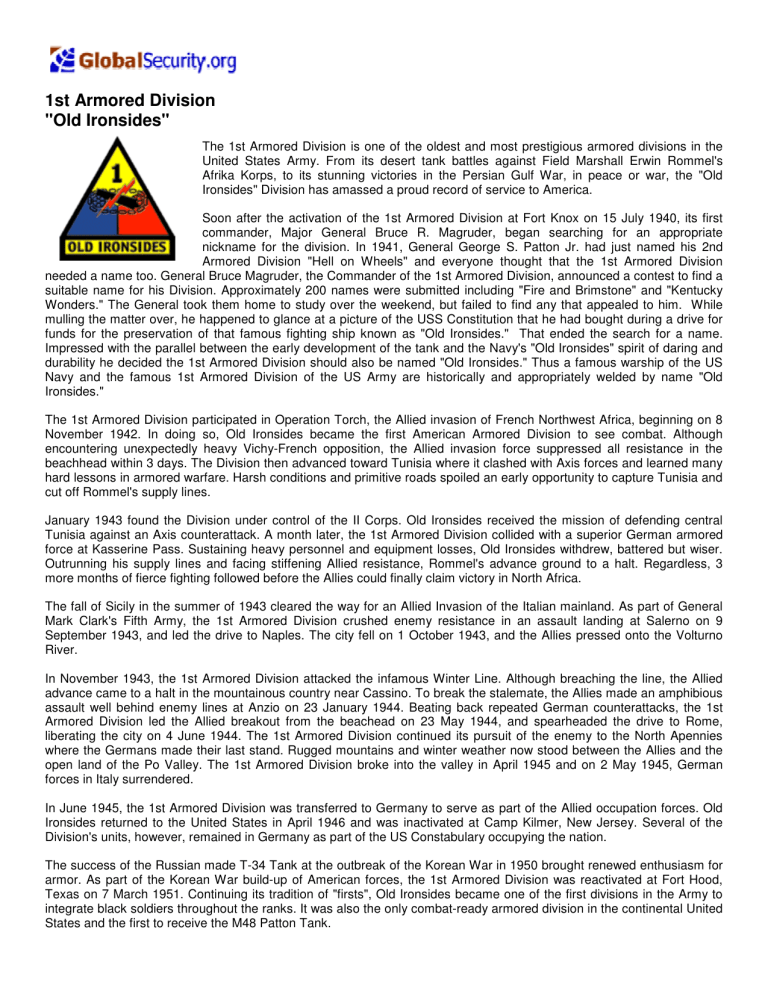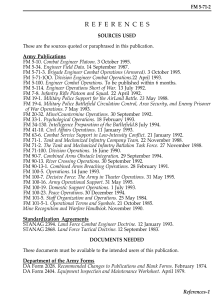1st Armored Division "Old Ironsides"

1st Armored Division
"Old Ironsides"
The 1st Armored Division is one of the oldest and most prestigious armored divisions in the
United States Army. From its desert tank battles against Field Marshall Erwin Rommel's
Afrika Korps, to its stunning victories in the Persian Gulf War, in peace or war, the "Old
Ironsides" Division has amassed a proud record of service to America.
Soon after the activation of the 1st Armored Division at Fort Knox on 15 July 1940, its first commander, Major General Bruce R. Magruder, began searching for an appropriate nickname for the division. In 1941, General George S. Patton Jr. had just named his 2nd
Armored Division "Hell on Wheels" and everyone thought that the 1st Armored Division needed a name too. General Bruce Magruder, the Commander of the 1st Armored Division, announced a contest to find a suitable name for his Division. Approximately 200 names were submitted including "Fire and Brimstone" and "Kentucky
Wonders." The General took them home to study over the weekend, but failed to find any that appealed to him. While mulling the matter over, he happened to glance at a picture of the USS Constitution that he had bought during a drive for funds for the preservation of that famous fighting ship known as "Old Ironsides." That ended the search for a name.
Impressed with the parallel between the early development of the tank and the Navy's "Old Ironsides" spirit of daring and durability he decided the 1st Armored Division should also be named "Old Ironsides." Thus a famous warship of the US
Navy and the famous 1st Armored Division of the US Army are historically and appropriately welded by name "Old
Ironsides."
The 1st Armored Division participated in Operation Torch, the Allied invasion of French Northwest Africa, beginning on 8
November 1942. In doing so, Old Ironsides became the first American Armored Division to see combat. Although encountering unexpectedly heavy Vichy-French opposition, the Allied invasion force suppressed all resistance in the beachhead within 3 days. The Division then advanced toward Tunisia where it clashed with Axis forces and learned many hard lessons in armored warfare. Harsh conditions and primitive roads spoiled an early opportunity to capture Tunisia and cut off Rommel's supply lines.
January 1943 found the Division under control of the II Corps. Old Ironsides received the mission of defending central
Tunisia against an Axis counterattack. A month later, the 1st Armored Division collided with a superior German armored force at Kasserine Pass. Sustaining heavy personnel and equipment losses, Old Ironsides withdrew, battered but wiser.
Outrunning his supply lines and facing stiffening Allied resistance, Rommel's advance ground to a halt. Regardless, 3 more months of fierce fighting followed before the Allies could finally claim victory in North Africa.
The fall of Sicily in the summer of 1943 cleared the way for an Allied Invasion of the Italian mainland. As part of General
Mark Clark's Fifth Army, the 1st Armored Division crushed enemy resistance in an assault landing at Salerno on 9
September 1943, and led the drive to Naples. The city fell on 1 October 1943, and the Allies pressed onto the Volturno
River.
In November 1943, the 1st Armored Division attacked the infamous Winter Line. Although breaching the line, the Allied advance came to a halt in the mountainous country near Cassino. To break the stalemate, the Allies made an amphibious assault well behind enemy lines at Anzio on 23 January 1944. Beating back repeated German counterattacks, the 1st
Armored Division led the Allied breakout from the beachead on 23 May 1944, and spearheaded the drive to Rome, liberating the city on 4 June 1944. The 1st Armored Division continued its pursuit of the enemy to the North Apennies where the Germans made their last stand. Rugged mountains and winter weather now stood between the Allies and the open land of the Po Valley. The 1st Armored Division broke into the valley in April 1945 and on 2 May 1945, German forces in Italy surrendered.
In June 1945, the 1st Armored Division was transferred to Germany to serve as part of the Allied occupation forces. Old
Ironsides returned to the United States in April 1946 and was inactivated at Camp Kilmer, New Jersey. Several of the
Division's units, however, remained in Germany as part of the US Constabulary occupying the nation.
The success of the Russian made T-34 Tank at the outbreak of the Korean War in 1950 brought renewed enthusiasm for armor. As part of the Korean War build-up of American forces, the 1st Armored Division was reactivated at Fort Hood,
Texas on 7 March 1951. Continuing its tradition of "firsts", Old Ironsides became one of the first divisions in the Army to integrate black soldiers throughout the ranks. It was also the only combat-ready armored division in the continental United
States and the first to receive the M48 Patton Tank.
Training for nuclear war became a major theme in the mid-1950s. Accordingly, the 1st Armored Division participated in tests of the "Atomic Field Army" at Fort Hood and in Operation Sagebrush, the largest joint maneuver conducted since
World War II. Upon completion of the exercise in February 1956, the 1st Armored Division moved to its new home at Fort
Polk, Louisiana.
Toward the end of the 1950s, the Army's preoccupation with a nuclear battlefield waned. The Army experienced years of austere budgets. Reduced in size and moved back to Fort Hood, the 1st Armored Division reverted to a training cadre for new inductees. The start of the 1960s, however, inaugurated a period of military renewal. Important changes in organization, doctrine, and equipment stemmed from the realization that the Army must be prepared to fight anytime, anywhere.
In 1962, the 1st Armored Division was brought back to full strength and reorganized. Brigades replaced its Combat
Commands, and the Division's aviation assets doubled. Intense training followed the reorganization. In October 1962, the
1st Armored Division was declared combat ready, just in time for the Cuban Missile Crisis. In response to the Soviet stationing of missiles in Cuba, Old Ironsides deployed from Fort Hood, Texas to Fort Stewart, Georgia. The entire operation took just 18 days. For the next six weeks, the 1st Armored Division conducted live-fire training and amphibious exercises on the Georgia and Florida coasts. One highlight was a visit from President John F. Kennedy on 26 November
1962. Shortly thereafter, tensions eased and the 1st Armored Division returned to Fort Hood.
Although the 1st Armored Division did not participate as a Division in the Vietnam War, 2 units, Company A, 501st
Aviation and 1st Squadron, 1st Calvary served with distinction. Both earned Presidential Unit Citations, and 1-1st Cavalry received 2 Valorous Unit Awards and 3 Vietnamese Crosses of Gallantry. Neither unit was officially detached from the 1st
Armored Division and veterans of both units were authorized to wear the Old Ironsides as a combat patch. In 1967, the
198th Infantry Brigade was formed from 3 of the Division's Infantry Battalions and deployed from Fort Hood to Vietnam.
After the war, 2 of the 3 battalions, 1-6th Infantry and 1-52nd Infantry, returned to the 1st Armored Division.
1968 was a crisis-filled year of domestic unrest. After the assassination of Martin Luther King, several inner cities exploded into violence. The 3rd Brigade, 1st Armored Division deployed to Chicago to assist in restoring order.
The early 1970's brought the withdrawal of American Forces from Vietnam and a major restructuring of the Army. Old
Ironsides was rumored to be on the list of units to be inactivated. Veterans of the Division organized a letter-writing campaign to "save" the 1st Armored Division. Their efforts were rewarded when on 10 May 1971, 1st Armored Division left its home at Fort Hood, Texas to replace the 4th Armored Division in Germany. There Old Ironsides marched into its second half century celebrating victory in the Cold War. This was a triumph symbolized by the fall of the Berlin Wall, the unification of Germany, and the crumbling of East European, communist regimes.
Almost immediately the 1st Armored Division was called upon to meet a new challenge. In November 1990, it was alerted for deployment to the Middle East in response to the Iraqi invasion of Kuwait. In less than 2 months the Division moved
17,400 soldiers and 7,050 pieces of equipment by rail, sea, and air to Saudi Arabia for Operations Desert Shield and
Desert Storm. The Division's own 1st Brigade stayed in Germany and was replaced by 3rd Brigade, 3rd Infantry Division.
On 24 February 1991, the 1st Armored Division crossed into Iraq, leading VII Corp's main flanking attack. Its mission was to destroy the elite Iraqi Republican Guards Divisions. In its 89-hour blitz across the desert Old Ironsides traveled 250 kilometers; destroyed 768 tanks, APCs and artillery pieces; and captured 1,064 prisoners of war. Four 1st Armored
Division soldiers made the ultimate sacrifice in this historic effort. Old Ironsides marked its successful return to Germany on 8 May 1991, when Major General Griffith uncased the Division Colors in Ansbach. The 1st Armored Division celebrated its triumph with a visit from the Vice President of the United States and attendance at victory parades in
Washington, DC and New York City.
On 14 December 1995, the 1st Armored Division was ordered to Bosnia-Herzegovina as part of Operation Joint
Endeavor. This task force, known as Task Force Eagle, assumed control of its area of responsibility during a transfer of authority ceremony with United Nations forces at Eagle Base, Tulza on 20 December 1995. After the historic bridging of the Sava River on 31 December 1995, the Old Ironsides Division, with supporting forces from V Corps, was joined by
Nordic-Polish, Turkish, and Russian brigades. The units comprised, in total, 12 Nations: Denmark, Estonia, Finland,
Iceland, Latvia, Lithuania, Norway, Poland, Russia, Sweden, Turkey, and the United States.
Task Force Eagle, one of the most powerful military formations ever fielded, enforced the cease-fire, supervised the marking of boundaries and the zone of separation between the former warring factions, enforced withdrawal of the combatants, and the movement of the heavy weapons to designated storage sites. Task Force Eagle also supported the
Organization for Security and Cooperation in Europe's efforts to administer the country's first ever democratic national elections. On 10 November 1996, the 1st Armored Division transferred authority for command and control of Task Force
Eagle to the 1st Infantry Division. The 1st Infantry Division deployed as a covering force to allow the safe return of the 1st
Armored Division to Germany.
In April 1999, the 1st Armored Division was alerted to send soldiers to Albania as part of Operation Allied Force in response to the ethnic cleansing and fighting in Kosovo. The 1st Armored Division then sent the first soldiers into Kosovo in operation Joint Guardian to uphold the United Nations Security Council resolution to bring peace back to the Kosovo region.
The 1st Armored Division began the year 2000 with a bang as the 1st Brigade Combat Team blasted its way through the rolling fog of Grafenwoehr Training Area in a challenging January gunnery. February 2000 saw 1st Armored Division
Headquarters announce the closure of military facilities in Bad Kreuznach and subsequent relocation to Wiesbaden scheduled for June 2001. The 1st Armored Division rocked HTA and GTA in 3 seperate exercises in March 2001. Ready
First stormed into Hohenfels Training Area for Mountain Guardian III, a Mission Rehearsal Exercise designed to test the limits of Iron Soldiers preparing to deploy to Task Force Falcon 2A.
The 1st Armored Division's command and control elements pushed the envelope during a highly effective Warfighter in
GTA, between March 21 and April 17 2001. The 1st Armored Division took command of Task Force Falcon in Kosovo as
Brigadier General Randal Tieszen accepted the colors from 1st Infantry Division's Brigadier General Ricardo Sanchez.
The 1st Armored Division celebrated its 60th birthday at home and abroad in Kosovo, on 15 July 2001. Major General
George W. Casey, Jr. traveled to Boston Harbor in August 2001 where he forged a new bond with Commander Bill
Foster, of the USS Constitution. The meeting rekindled the fires of a 60-year love affair between the prestigious ship "Old
Ironsides" and 1st Armored Division.
The 1st Armored Division received orders on 4 March 2003, to deploy to the US Central Command area of responsibility in support of the global war on terrorism and to prepare for future contingencies as may be directed. The deployment was to consist of the whole division. However, on 14 March 2003, Stars and Stripes reported that 1st Armored Division had been ordered to put their deployment on hold as transporting the Division's equipment to the AOR had been complicated by the refusal of Turkey to permit the 4th Infantry Division to stage from its territory. Old Ironsides began moving out on 15
April 2003 in support of Operation Iraqi Freedom.
The Division and its associated task force marked some major firsts during the 15-month long mission. For Soldiers of the
1st Armored Division, this was longest deployment of any division in Iraq up to that point. Task Force 1st Armored Division was the largest division-based task force in US Army history up to that point. Units serving with the Task Force included brigade-sized elements of the 82nd Airborne and 3rd Infantry and 1st Cavalry Divisions, the 2nd Armored Cavalry
Regiment, the 124th Infantry Battalion, the 18th and 89th Military Police Brigades and 168th MP Battalion. Engineer units serving with the task force included the 153rd, 203rd, 389th, 439th, 535th, 842nd and 1457th Engineer Battalions, the
493rd Engineer Group, and the 249th and 671st Engineer Companies. Also serving the task force were the 55th
Personnel Service Battalion, the 8th Finance Battalion, the 350th and 354th Civil Affairs Battalions, the 315th and 345th
PSYOP Battalions and the 16th Corps Support Group. At its height, more than 39,000 Soldiers were part of the task force.
The task force secured some of Baghdad’s roughest neighborhoods and brought stability to the city and its surrounding countryside. The Task Force's accomplishments included planning and executing Operations Iron Hammer, Iron Justice,
Iron Grip, Longstreet, Iron Bullet, Iron Promise and Iron Sabre. During these task force operations, soldiers captured more than 700 criminals and former regime insurgents. They also confiscated thousands of rockets, mortars, tank rounds, rocket-propelled grenades and small arms.
In addition to combat, task force Soldiers protected and improved the quality of life for over 5 million Iraqi residents in the city of Baghdad. The task force trained Iraqi police and national guardsmen, renovated schools, established neighborhood councils and spent over $60 million on these and other projects. After turning the city over to the 1st Cavalry Division on
15 April 2004, the task force headed south to pacify the cities of Najaf, Diwaniyah, Al Kut and Karbala.
Extended for 120 days to tackle the new mission, elements of the task force moved south and took over 17,000 square kilometers in southern Iraq to dismantle a radical militia that had taken control of a number of cities and was trying to discredit its nation’s new-found freedom. In 60 days of combat operations, Task Force 1st Armored Division defeated the militias and restored stability to the nation's southern region. Those mission successes and achievements did not come without cost. During the opening phases of Operation Iraqi Freedom, 133 Iron Soldiers lost their lives while serving in Iraq and 1,111 were wounded in combat.
In the DoD's 2005 BRAC report, DoD recommended relocating 1st Armored Division from Germany to Fort Bliss, Texas.
Relocating 1st Armored Division units and echelons above division (EAD) units to Fort Bliss would transform it from an institutional training installation into a major mounted maneuver training installation and would avoid overcrowding and overuse at other installations. The departure from Germany would subsequently be combined with the reorganization of the Division under the US Army's new modular force structure.
As part of the transformation, various division level assets were made organic to the newly reorganized and redesignated brigade combat teams. The Division Support Command, Division Artillery, Division Engineer Brigade, 1-4th Air Defense
Artillery, 501st Militry Intelligence Battalion, 501st Military Police Company, and 141st Signal Battalion were all inactivated.
The 1-1st Cavalry was inactivated and reactivated as part of the 2nd Brigade Combat Team. The Aviation Brigade was reorganized and redesignated as Combat Aviation Brigade, 1st Armored Division, while a fourth brigade, 4th Brigade
Combat Team, 1st Armored Division, was activated. By 2010, all the major units of the 1st Armored Division had relocated to Fort Bliss, Texas.
The 1st Armored Division also became home to the US Army Evaluation Task Force (AETF), also known as 5th Brigade
Combat Team, 1st Armored Division. Initially the unit was used to test various elements of the Future Combat Systems program. The 5th Brigade Combat Team became the testbed for improvements under the Army Brigade Combat Team
Modernization program after the cancellation of the FCS program in 2009.

